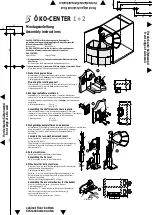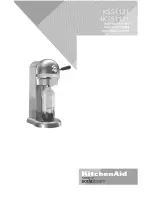
8
JUICING TIPS
1. Although the juice drinks contained in this manual were developed with flavor, texture and aroma at
the forefront, the health benefits certainly add to the pleasurable taste experience.
2. 95% of the nutrient content of fruits and vegetables are found in the juice. Liquids extracted from
fresh fruits and vegetables foam an important part of a well-balanced healthy diet. Fresh fruits and
vegetables juices are an easy way to introduce a source of vitamins and minerals to your diet.
Juices are rapidly absorbed into the stream therefore being the quickest way in which the body can
digest nutrients.
3. When you make your own juices, you have complete control over what you include in them. You
select the ingredients and decide if you need to use sugar, salt or other flavoring agents.
4. Freshly extracted should be consumed just after they have been made to avoid a loss of vitamin
content.
(THE RIGHT TECHNIQUE)
1. When juicing a variety of ingredients with varying textures, start with the softer textured ingredients
on a low speed then change to high speed for the harder textures ingredients.
2. If you are juicing herbs, spouts or leafy green vegetables either wrap them together to form a
bundle or juice them in the middle of a combination of ingredients on low speed to obtain the best
extraction.
3. If juicing herbs or leafy green vegetables on its own, the juice yield will be low due to the nature of
centrifugal juicing. It is best to juice them with a combination of other fruits and vegetables.
4. All fruits and vegetables produce different amount of liquids. This varies within the same group for
example one batch of tomatoes can produce more juice than another batch. Since juice recipes are
not extracted, the precise quantities of any juice are not crucial to the success of the recipe.
5. To extract the maximum amount of juice, always push the food pusher down slowly.
(GETTING THE RIGHT BLEND)
1. It is easy to create great tasting juice. If you have been making your own fruits and vegetables
juices, then you know how simple it is to invent new combinations. Taste, color, texture and
ingredients preference is a personal thing. Just think of your favorite flavors and foods would work
well together or would they crash? Some strong flavors could overpower more subtle flavors. A
good rule of thumb is to combine starchy, pulpy ingredients with those high in moisture.
(USING THE PULP)
1. The remaining pulp left after juicing fruits and vegetables are mostly fiber and cellulose which, like
the juice that contains vital nutrients necessary for the daily diet. Pulp can be used in many ways,
however, like the juice, pulp should be used the same day to avoid the loss of vitamins.
2. Pulp can be used to bulk out casseroles or soups. Fruit pulp can be simply placed in a bowl, topped
with meringue and baked a simple desserts.
3. Pulp is also greatly used in garden for compost.
4. When using the pulp, there are may pieces of fruits and vegetables remaining. These should be
removed before using the pulp in any recipes.
Summary of Contents for EJE-9811A
Page 16: ...15...


































